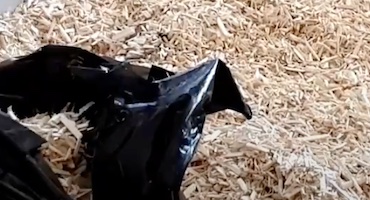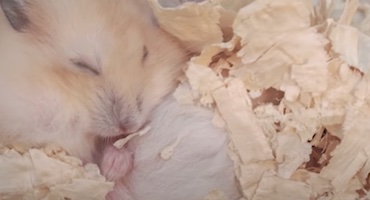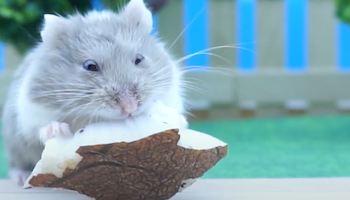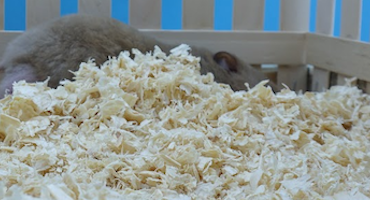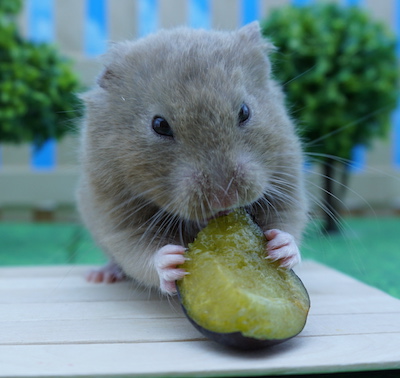
However, just like any other sweet fruit, there are a few essential things you need to remember before you give plums to your hamster friends. Here is everything you need to know about feeding plums to your hamsters.
Plums are quite sweet and acidic in nature, which is why you can feed your Syrian hamsters with a small serving of plum just about once a week as a treat. However, you need to make sure that you do not overfeed your hamsters with this, as it can be quite risky for your pets.
Campbell’s Dwarf hamsters are much smaller in size with a far more delicate digestive system. You cannot feed these hamsters very acidic or sugary foods as they are very susceptible to developing diabetes and obesity. It is best that you do not feed the sweet plums to your Campbell’s Dwarf hamsters.
Winter whiter dwarf hamsters are also a species of dwarf hamsters who are highly susceptible to developing diabetes and obesity. You should avoid feeding these dwarf hamsters with a sugary treat like plums as it can be quite harmful to them.
Roborovski hamsters are very similar to Syrian hamsters. These hamsters are more giant, more robust, and have a stronger digestive system. Even though these hamsters are also prone to developing diabetes and obesity, they have a stronger digestive system to process sugary treats occasionally. You can feed your Roborovski hamsters plums as a treat just once a week.
Chinese hamsters are also a kind of dwarf hamster species. You should altogether avoid giving these hamsters plums as it can be quite harmful to their health.
There are several species of wild hamsters which still live in the wild in many places all around the world. In the wild, these hamsters are mostly omnivorous, which means that they eat both plants as well as animals. Hamsters in the wild are scavengers. They eat fruits and wild berries, vegetables, nuts, grains, seeds, insects, small frogs, and even lizards if they can find them!
Domesticated hamsters are the little pet hamsters which you keep in your homes. You can keep your pet hamsters on a healthy diet of exceptional hamster food, but of course, the occasional fruits and vegetables are a wonderful treat for your little hamsters. It is vital that you know which foods are safe for your hamsters and which ones can be dangerous for them.
What are the health benefits of your hamsters eating plums?
Plums are a fleshy, purple or red colored fruit available seasonally. They have a citric, yet sweet taste to them and are quite beneficial for health. Plums have dietary fibers, Vitamin C, carbohydrates, potassium, and Vitamin K in them.
The dietary fibers in plums are high for your hamster’s digestive health. They aid your hamster’s digestive system, relieving constipation, and encouraging a healthy bowel movement by providing fibers.
Vitamin C present in plums are high for your hamster’s eye health as well as promoting healthy fur on your hamster’s body.
Carbohydrates in plums are fruit sugars which provide energy and prevent anemia in your hamsters.
Potassium is excellent for your hamsters as it lowers the risk of blood pressure and stroke as well as heart diseases in hamsters.
Vitamin K in plums are great for bone metabolism and play a huge role in blood clotting.
What are the health risks of your hamsters eating plums?
Plums contain a high concentration of citric acid and sugars. Overfeeding plums to your little hamsters can cause them to develop diarrhea, obesity, and diabetes. Since your dwarf hamsters are much smaller than Syrian and Roborovski hamsters, they are at a more significant risk of developing these diseases, which is why you should avoid feeding them plums.
Hamsters also have a habit of hoarding away their food in their cages. If you do not regularly clean out their cages, the leftover bits of plum can rot and cause health problems in your hamsters.
Can you give dried plums to your hamster?
Dried plums are quite sugary, sticky, and sweet as a treat. While it is best that you avoid feeding dried plums to your hamsters, if you wish, you can feed one small piece of dried plum to your Syrian and Roborovski hamsters, just about once a week only. Remember to give them a tiny part, as the stickiness of the fruit can cause it to become stuck to the hamster’s cheek pockets.
As for your Dwarf hamsters, you should never feed them dried plums as it is too sugary and sticky and will do them more harm than good.
Can you feed plum pits, leaves and skin to your hamsters?
Your Syrian and Roborovski hamsters can digest a little treat of plums occasionally, about once a week only. However, when you feed plums to your hamsters, be sure always to remove the plum pits, as they can be a choking hazard for your hamsters. As for the plum skin, yes, you can feed this to your hamsters. However, you need to wash the plums very thoroughly before you give it to your hamsters so that you remove any dirt, chemicals, or pesticides from the outer skin of the plums.
Avoid feeding plum leaves to your hamsters as well, as it can be toxic for hamsters.
How many plums can you feed your hamster?
When it comes to your Syrian and Roborovski hamsters, a quarter teaspoon serving of plums once a week is enough for them, as this fruit is very sugary and citrusy for your hamsters. However, you should altogether avoid feeding plums to your Dwarf hamsters, such as Campbell’s Dwarf hamsters, Winter Whites Dwarf Hamsters, and Chinese Hamsters. These Dwarf hamsters are far more susceptible to developing diabetes and obesity.
Conclusion
The best diet to keep your hamsters on is a healthy and balanced diet of exceptional hamster food, and the occasional fruits, nuts, grains, seeds, and vegetables as well. Be sure not to overfeed these to your hamster and only give them as a treat every once in a while, since your hamsters are prone to developing obesity and diabetes.
Share
Related Posts
When it comes to feeding the right foods to your little hamster pets, many pet owners can often [...]
Dwarf hamsters are a small species of hamsters which grow just about 4 inches in size. These hamsters [...]

